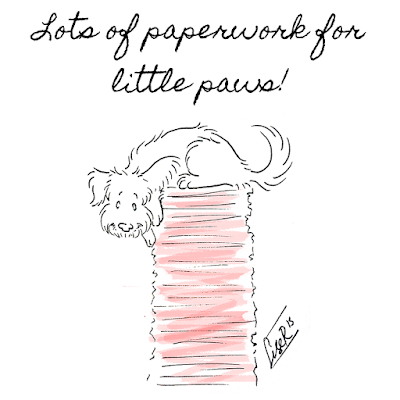Having thoroughly planned, packed, and panicked, we set off to Helsinki the night before our flight to Brussels. I doubt anybody slept that night, including the dogs. Mum and I were very nervous about Kara's weight - Finnair allows dogs in the cabin if they, with their bag, weigh 8kg or under, and the previous day Kara weighed just under 7kg without the bag. Here I must mention that the information given on flying with pets varies depending on the source, and though I did do a lot of googling to check every single little detail prior to the flight, I can't say I was particularly confident about how we'd manage.
As it turned out, Kara weighed 7.9kg with her bag, and gleefully we dashed through the terminal, both dogs in tow, with none too many minutes to spare at the departure gate. Next it was time to worry about Freija - how on earth would she stay put under the seat in front of mine for the full two and a half hours? More importantly, at this point I kept all my fingers and toes crossed that she wouldn't panic and start screaming bloody murder as she can sometimes do in nervous situations...
So on we went, our seats being the very last at the back of the plane. The space under the seats in front of ours was cramped to say the least, though thankfully the soft Trixie bags we'd bought solely for the flight did squash down somewhat and both doggies were lodged reasonably comfortably in their places for the duration of the flight. As we set off, Freija was nervous as I'd expected, and whined from the runway till we got above the clouds - happily a bit of soothing rocking her bag on my part seemed to help, and she settled down eventually. In fact, the flight from there on out was incredibly peaceful with both dogs sleeping most of the time.
When we landed (and breathed for the first time in 24 hours, I feel) Kara had a bit of a Bambi moment - somebody hadn't moved a muscle for over two hours and ended up with paws of spaghetti! What a laugh we had at that, while simultaneously dashing to collect our luggage and meet the pet taxi who would be collecting us for the trip from Brussels to Folkestone...
It was a short and peaceful drive across the border. Our driver amused us with stories of other pets they'd traveled with, and said how surprisingly many of them got stopped at the pet passport check in Calais due to a multitude of ridiculous reasons - we chuckled and said how glad we were our passports had been checked by our vet just days before departure to ensure we'd be safe to travel.
Oh how wrong we were.
Upon entering the pet reception building, one of the personnel pounced at Freija, who I was carrying, to check her microchip. Girly girl freaked out and I ended up with a pee-covered shirt - the least of my worries towards the end of the night. With both of the dogs microchips found, they started looking through the pet passports. Kara's went through no problem, she was cleared to travel. Then things went very, very wrong. The ladies behind the desk gathered round Freija's passport, shaking their heads and muttering in French. My heart sank - something was obviously amiss. To sum up (and leave out hours of exasperation, tears, negotiation, and fear), here's what was wrong:
- Instead of the issue date of the microchip, ours had the reading date of the microchip. This was very obviously bad because the microchip has to be inserted BEFORE the rabies vaccination is given, and of course these were in the wrong order as Freija received her passport in January.
- The vet had not stamped the passport, neither on the main page or on the vaccination pages.
- The rabies vaccination had not been laminated.
Our driver from the night before kindly came back for us, and we whizzed past the traffic (you'll all know about the migrant crisis in Calais this summer), through the pet passport check and border control. We got through to the tunnel rather quickly, with just enough time to spare for a quick wee for the dogs before loading up the pet taxi into the sweltering hot train. It was an uncomfortable journey in the heat, but short - withing 45 minutes we were in Folkestone, apologising profusely to my granddad who had come to meet us the night before, only to have to turn back home and come again that day.
After a blissful night of sleep in Eastbourne we were thoroughly prepared for the drive to Somerset. Granddad had borrowed a minibus from work, which easily accommodated three large suitcases, a few bits and pieces of furniture, three people, and two small dogs - so off we set just after five in the morning. There are few things as beautiful as the English countryside at dawn, especially that drive from East Sussex through to the West, onto Hampshire, Wiltshire, and eventually Somerset and Avon. It's especially delightful after the ordeal of the previous couple of days, I must say.
We arrived in Bath around ten that morning, via a quick brekkie stop at Wetherspoons in Warminster,
and spent the day buying furniture, kitchenware, and other immediate essentials, and setting up my and Freija's new flat. It's a gorgeous flat, in a gorgeous area, and that night I think we couldn't have felt any happier to be home.






























